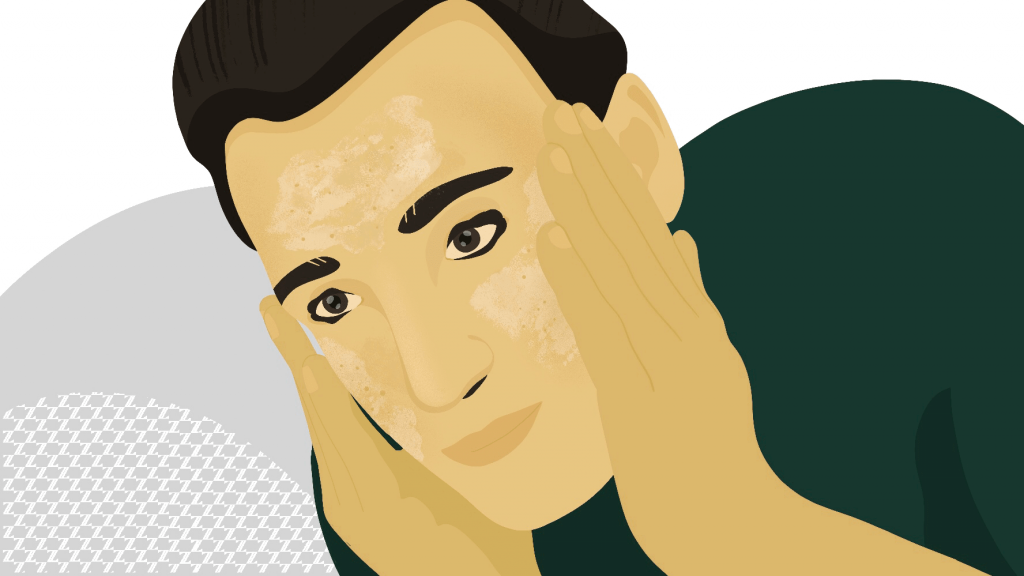Health
What is seborrheic dermatitis on the face and how can I treat it
Published
5 years agoon
By
Farhan Malik
The seborrheic dermatitis is one of those chronic skin diseases manifested by outbreaks. Although there is no definitive cure, seborrheic dermatitis requires a series of care to space and reduce the severity of the outbreaks, which usually require pharmacological treatment. And within these cares, cleaning and subsequent hydration, carried out with suitable products, are of vital importance, best facial cleanser for seborrheic dermatitis.
There are differences in the symptoms and treatment of seborrheic dermatitis on the face when we talk about babies and when we refer to adults. Today we are going to focus on adult seborrheic dermatitis , which has no definitive cure but can be kept under control.
Facial seborrheic dermatitis in adults
The seborrheic dermatitis in adults may occur on the trunk, areas of skin folds, face and scalp, where the skin the most difficult area to protect because it is the most exposed and because it usually requires hygiene and care different from those used on the body or scalp.
In addition, some pharmacological treatments such as topical creams with corticosteroids, necessary to control outbreaks of a certain intensity, require very careful use on the face, since adverse effects – sometimes permanent – of such medications.
To understand how we should take care of our skin if we suffer from seborrheic dermatitis (SD), it is best to start by explaining what seborrheic dermatitis is and what its causes are, along with the most characteristic symptoms in adults, which is the topic at hand.
Adult seborrheic dermatitis is a chronic skin disease , as are psoriasis and atopic dermatitis. And, as with these other diseases, the immune system is involved in outbreaks or crises, which can also be due to various causes. As if that were not enough, the three diseases mentioned are pruritus and scaling, so it is best to go to a dermatologist to verify the diagnosis.
Diagnosing an adult DS is not always easy, and it may be necessary for the doctor to scrape off the skin scales to send the sample to be analyzed. There is even a type of adult seborrheic dermatitis that shares symptoms with psoriasis on visual diagnosis (atopic dermatitis is better distinguished).
The causes of adult seborrheic dermatitis are varied and do not always occur all at once.
- There is a genetic component that explains why in some families there is a high incidence of cases, but it is not an inherited disease by itself.
- External factors such as poor hygiene or the use of cleaning products or occlusive cosmetics can be the origin of adult seborrheic dermatitis in people who already showed a certain predisposition, so be careful with our facial, hair and body care routine.
- Although it can appear at almost any age, the most common is that seborrheic dermatitis manifests itself for the first time between 40 and 60 years of age, with a higher incidence in the male population, since they already have a more oily skin.
- Indeed, the accumulation of sebum in the skin worsens DS pictures.
The cases of adult seborrheic dermatitis that are best distinguished by visual diagnosis present with erythematous plaques with well-defined borders, within which scaling is observed. These scales of skin are whitish or yellowish and have an oily appearance, which gives the disease its name. However, as treatments for seborrheic dermatitis seek, among other things, to control excess sebum, cases of patients with drier-looking peeling can be seen, even with skin that lacks hydration.
Seborrheic dermatitis causes itching, more or less accentuated depending on the severity of the case and whether we are facing an outbreak or not. On the face, the skin is thinner and scratching lesions much more frequent.
It is not common, although there are cases in which adult seborrheic dermatitis also affects the eyelids, which requires the use of specific products to clean this area. In general, the areas of the face most affected by seborrheic dermatitis are the eyebrows, the wings of the nose, and the hairline on the forehead and temples, although many people also have symptoms on the cheeks, chin and inside the auditory pinna. Hygiene is essential in all cases.
Treatments for seborrheic dermatitis on the face in adults
In mild cases, seborrheic dermatitis of the face can be controlled with good hygiene combined with the use of moisturizing but non-occlusive cosmetics, such as our face serums . By the way, we remind you that our hair serum is also suitable for all types of scalps, including seborrheic ones.
Hygiene of a skin with seborrheic dermatitis should be carried out with soap and water, a non-occlusive soap, in mild cases, or alternating products with a certain fungicidal action with soapy cleaning in more complicated cases. The face should be washed twice a day, even more if we notice that it is necessary in summer or for sports. The aim is to carry out a dragging effect on excess sebum and, when necessary, to control opportunistic fungal infections that can prevent outbreaks from remitting.
And, now that we talk about outbreaks, the treatment of seborrheic dermatitis involves avoiding all the factors that worsen the clinical picture of each patient in particular. Stress is usually the cause of many outbreaks of seborrheic dermatitis, although the intake of certain foods and, we repeat, the use of inappropriate skin care products can also influence. However, facial seborrheic dermatitis in adults tends to get worse in the fall and winter months, whatever we do.
Regarding the hydration of adult skin with seborrheic dermatitis, we must choose light and non-greasy textures, capable not only of hydrating, but also of providing the skin with the care it needs due to its biological age and even of reversing the damage that they can produce the washing gels with fungicidal actives. Regenerating the skin without adding lipids is somewhat complicated, that is why at Riscell we have opted for epidermal growth factors , which allow us to cover the regeneration needs of any type of skin with very light formulas.
How to clean the face with seborrheic dermatitis?
Although it may surprise you, with a relatively vigorous wash you can increase the cleaning power of the products that are used. Remember that afterwards the hydration will be specific and will contribute regeneration to the skin.
When there is a lot of flaking, cleaning products with urea or alpha-hydroxy acids can be used.
What about professional facial cleanses? Can I go to my beauty center if I suffer from seborrheic dermatitis?
Our advice is that if you find yourself in the middle of an outbreak, do not undergo deep cleaning, as it could do you more harm than good because your skin is inflamed and without defenses.
In other cases, between outbreaks, you can perform facial cleansing in the cabin as long as you put yourself in the hands of professionals and use products adapted to your specific needs. Another option is to carry out the home version of these cleanings at home, investing in simple devices such as a facial sauna, to be sure that everything that touches your skin is suitable for skin with seborrhea. If you do facial cleansing at home, they will be a little less deep than if you do them in the cabin, so you will have to repeat them every week or ten days, although with the money you save you can invest in the best products for cleaning and post-treatment to the same.
In summary, adult seborrheic dermatitis is a chronic skin disease that has no definitive cure. Its treatment is focused on avoiding outbreaks, which are the times when infections caused by opportunistic microorganisms can arise and, in any case, you will suffer a lot of discomfort.
A good cleaning and subsequent hydration, always carried out with products suitable for your skin type, will be your allies to space outbreaks and minimize their intensity.
You may like

Is Fmovies Safe? What You Need to Know Before Streaming

Dominating the Digital Pitch: A Step-by-Step Guide to Creating Futbol Libre Content

Conquering CricHD: A Comprehensive Guide to Cricket Streaming

What You Need to Know About Police Brutality?

12 Sites to Watch Free Online TV Shows with Complete Episodes in 2024


